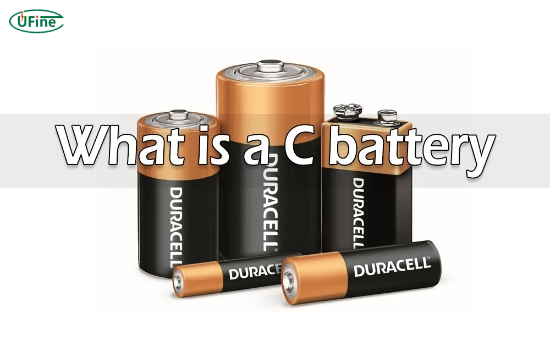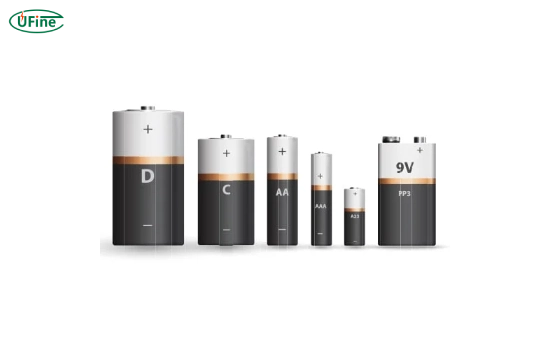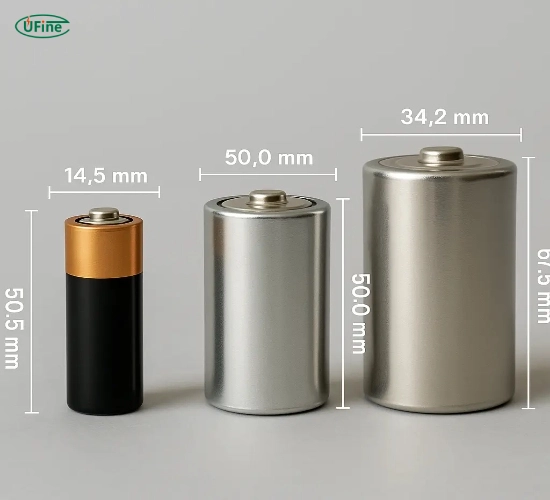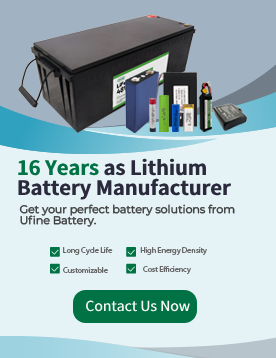
- Part 1. C Type battery overview
- Part 2. What is a C type of battery?
- Part 3. Types of C type batteries
- Part 4. How to choose the right C type of battery?
- Part 5. How to properly store C type batteries?
- Part 6. Typical applications of C type batteries
- Part 7. Comparing C type batteries with other common battery sizes
- Part 8. FAQs about C type battery
C type battery (also called C cell battery) is a standard 1.5V cylindrical battery measuring about 50mm in length and 26.2mm in diameter. It is commonly used in flashlights, toys, radios, and musical instruments. Compared with AA batteries, C batteries provide higher capacity (up to 8000–9000mAh) and longer runtime.
- Voltage: 1.5V (Alkaline/Lithium), 1.2V (Rechargeable NiMH)
- Size: 50mm × 26.2mm
- Common Name: C cell battery / Battery type C
C type batteries power various devices, from toys to flashlights. Their unique size and capacity make them a popular choice for applications that require moderate energy consumption. This guide will explore the different types of C type batteries, their advantages and disadvantages, and how they compare to other standard battery sizes. Understanding these aspects will help you make informed decisions when selecting the correct battery for your needs.
Part 1. C Type battery overview
The C type battery, also called a C cell, is a mid-sized cylindrical battery that bridges the gap between AA and D batteries. It offers higher energy capacity than smaller cells while keeping a compact size. Available in alkaline, NiMH, lithium, and zinc-carbon types, C batteries are ideal for medium-drain devices like toys, radios, and flashlights.
Part 2. What is a C type of battery?
Quick Answer: A C type battery (or C cell) is a standard 1.5V cylindrical battery measuring 50mm x 26.2mm. It powers medium-drain devices like flashlights, toys, and portable radios, offering higher capacity than AA batteries but smaller size than D batteries.
C type batteries are primarily used in applications that require moderate current draw, such as:
- Flashlights
- Toys
- Portable radios
- Musical instruments
Their design balances size and capacity, making them suitable for devices requiring longer runtime than smaller batteries.
Advantages of C Type Batteries
C type batteries offer several advantages, including:
- Versatility: They can power various devices, from toys to flashlights.
- Availability: C type batteries are widely available in stores and online, making them easy to replace.
- Cost-Effective: While rechargeable batteries may have a higher upfront cost, they can save money over time by reducing the need for frequent replacements.
- Performance: Many C type batteries, incredibly alkaline and lithium, provide reliable performance and long-lasting power.
Disadvantages of C Type Batteries
While C type batteries are popular, they also have some drawbacks:
- Environmental Concerns: Non-rechargeable batteries contribute to landfill waste. It’s essential to recycle them properly.
- Self-Discharge Rate: Some rechargeable batteries may lose charge over time, even when unused.
- Cost of Rechargeables: The initial investment for rechargeable batteries and chargers can be higher than disposable options.
Part 3. Types of C type batteries
C type batteries come in several chemistries, each with its characteristics and applications. The most common types include:
- Alkaline Batteries are the most widely used C type batteries. They offer good energy density and a long shelf life, making them ideal for everyday devices.
- NiMH (Nickel-Metal Hydride) Batteries are rechargeable and environmentally friendly. They can be reused multiple times, reducing waste. They have a lower voltage than alkaline batteries but are suitable for high-drain devices.
- Lithium Batteries Known for their lightweight and high energy density, lithium C type batteries are often used in high-performance devices. They have a longer shelf life and can operate in extreme temperatures.
- Zinc-carbon batteries are the least expensive option but have a shorter lifespan and lower energy density than alkaline batteries. They are suitable for low-drain devices.
Distinguishing Between Different Types of C Type Batteries
When choosing a C type battery, it’s essential to understand the differences between these types:
- Performance: Alkaline batteries perform best for most applications, while NiMH batteries excel in high-drain situations.
- Rechargeability: NiMH and lithium batteries are rechargeable, saving money over time and reducing waste compared to single-use alkaline batteries.
- Cost: Alkaline batteries are generally less expensive upfront, but rechargeable options may be more cost-effective in the long run.
If you are wondering what types of C batteries are available or which C battery lasts the longest, here’s a quick summary of the main chemical types and their best uses. Each battery chemistry provides unique voltage, capacity, and shelf life characteristics.
C Battery Types: Performance Comparison
| Type | Voltage | Capacity | Best For |
|---|---|---|---|
| Alkaline | 1.5V | 8,000mAh | Everyday devices |
| NiMH | 1.2V | 6,000mAh | High-drain toys/cameras |
| Lithium | 1.5V | 9,000mAh | Extreme temperatures |
Part 4. How to choose the right C type of battery?
When selecting a C type battery, consider the following factors:
- Device Requirements: Check the device specifications to determine the required voltage and current. Some devices perform better with specific battery types.
- Usage Frequency: For devices used frequently, rechargeable batteries like NiMH may be more economical in the long run.
- Shelf Life: If you need batteries for emergency use, opt for alkaline or lithium batteries with a longer shelf life.
- Environmental Impact: Consider using rechargeable batteries to minimize waste and reduce your carbon footprint.
Top C Battery Brands We Recommend
- Energizer: Best for high-drain devices
- Duracell: Longest shelf life (12 years)
- Panasonic Eneloop: Top rechargeable C batteries
Where to Buy C Type Batteries
You can purchase C type batteries from major online stores and local retailers. For bulk or customized solutions, consider contacting a lithium battery manufacturer like Ufine Battery, which offers OEM and ODM services for lithium, NiMH, and special-sized batteries. Whether you need rechargeable C batteries or high-capacity lithium C cells, Ufine can customize the best option for your device.
Part 5. How to properly store C type batteries?
To ensure the longevity of your C type batteries, follow these storage tips:
- Keep in a Cool, Dry Place: High temperatures and humidity can affect battery performance.
- Store in Original Packaging: This helps prevent short-circuiting and protects the terminals.
- Avoid Mixing Battery Types: Using different types of batteries in the same device can lead to leakage or damage.
- Check Expiration Dates: Always use batteries before their expiration date for optimal performance.
Part 6. Typical applications of C type batteries
C type batteries are used in various applications, including:
- Toys: Many battery-operated toys require C type batteries for more extended playtime.
- Flashlights: C cells provide the necessary power for bright, long-lasting illumination.
- Musical Instruments: Some electronic instruments rely on C type batteries for portability.
- Portable Electronics: Devices like radios and speakers often use C type batteries for convenience.
What Does a C Battery Look Like?
A C battery looks like a thick cylinder, similar in height to an AA battery but almost twice its diameter. Below is a size comparison of C batteries vs AA, AAA, and D batteries to help you recognize them easily.
Part 7. Comparing C type batteries with other common battery sizes
C type batteries are often compared to other battery sizes, such as D, AA, and AAA batteries. Here’s a breakdown of their differences:
| Battery Type | Size (mm) | Voltage | Common Uses |
|---|---|---|---|
| C | 50 x 26.2 | 1.5V | Toys, flashlights, radios |
| D | 61.5 x 33.2 | 1.5V | High-drain devices like large flashlights and portable speakers |
| AA | 50.5 x 14.5 | 1.5V | Remote controls, cameras, and small electronic devices |
| AAA | 44.5 x 10.5 | 1.5V | Small electronics like TV remotes and portable games |
Key Differences
- Size and Capacity: D batteries are larger and have a higher capacity than C batteries, making them suitable for devices that require more power. AA and AAA batteries are minor and typically used in low-drain devices.
- Voltage: All these batteries generally provide the same voltage (1.5V), but their capacity and energy density differ significantly.
- Applications: C batteries are ideal for moderate-drain devices, while D batteries are better for high-drain applications. AA and AAA batteries are used in everyday electronics that require less power.
Part 8. FAQs about C type battery
What are C type batteries used for?
C type batteries are mainly used in toys, flashlights, radios, and musical instruments. They provide more power than AA batteries but are smaller than D cells.
What is the difference between C and D batteries?
D batteries are larger and store more energy (up to 18,000mAh), while C batteries are smaller (around 8,000mAh) and better for medium-drain devices.
Are C and C cell batteries the same?
Yes, “C battery” and “C cell battery” refer to the same 1.5V cylindrical size (50×26.2mm). They are often labeled interchangeably.
Can I use AA batteries instead of C?
Only with an adapter, but it’s not ideal. AA batteries have lower capacity and shorter runtime, so your device may perform poorly.
What type of C battery lasts the longest?
Lithium C batteries last the longest with up to 9,000mAh capacity and 10-year shelf life, ideal for emergency devices or high-drain electronics.
Which lasts longer: C or D batteries?
D batteries typically last 2-3 times longer than C cells due to their larger size (12,000-18,000mAh vs 8,000mAh). However, C batteries are preferred when space and weight are concerns.
What are the best C batteries?
For disposable options, Energizer Ultimate Lithium (9,000mAh) and Duracell Optimum (8,500mAh) lead in capacity. For rechargeables, Panasonic Eneloop Pro (5,000mAh) offers 500+ charge cycles.
Can I recharge regular C batteries?
No – only specifically marked “rechargeable” C batteries (NiMH or Li-ion) can be recharged. Attempting to recharge alkaline batteries may cause leakage or explosion.
Why do my C batteries die so quickly?
Fast drainage usually indicates: 1) Using zinc-carbon instead of alkaline, 2) Mixing old/new batteries, 3) High-drain device needs lithium batteries, or 4) Storing in extreme temperatures.
How should I store unused C batteries?
Store in a cool (15-25°C), dry place at 50% charge for rechargeables. Keep in original packaging and avoid metal contact. Proper storage can extend shelf life to 10 years for lithium batteries.
About Ufine Battery
Ufine Battery is a professional lithium battery manufacturer specializing in OEM and ODM solutions. Although not the largest company, Ufine is known for its custom battery design, quick delivery, and support for small orders starting from one piece. If you are looking for customized C type lithium batteries or other rechargeable solutions, Ufine can provide the perfect match for your project.
Related Tags:
More Articles

Battery Load Test: A Comprehensive Guide
Step-by-step battery load test guide for car, solar & industrial use. Learn how to load test a battery, interpret voltage charts, and avoid common mistakes.
The Comprehensive Guide to Battery Balancing and Battery Balancer
Discover how battery balancers improve lithium battery performance, lifespan, and safety. Learn types, functions, and tips to choose the right balancer.
What Is the Best Voltage for a Chainsaw Battery?
Compare 12V-80V chainsaw batteries for light pruning, medium firewood, and professional cutting. See best battery chainsaw with runtime charts and safety tips.
Lithium VS. Alkaline Batteries: A Comprehensive Comparison
Lithium batteries last 3–7× longer than alkaline and perform better in cold weather. Compare lifespan, cost, safety, and best uses to choose the right battery.
Comparing Lithium-Sulfur and Lithium-Ion Batteries: Which is Right for You?
Compare lithium-sulfur (Li-S) and lithium-ion batteries on energy, lifespan, cost, safety, and applications. Best choice for drones, EVs, and electronics.





